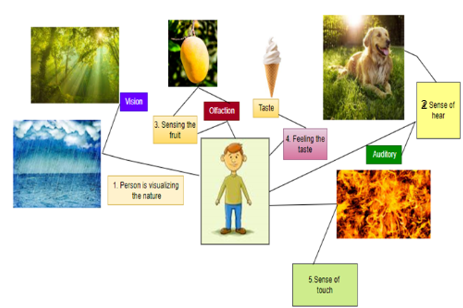Building Semantic Knowledge Base for the Visual Perception- Cognitive Ability of Neuropsychology Using Web Ontology Language
Keywords:
Visual Perception, Psychology, Brain, eye, Mid-brain, CogniFitAbstract
Cognitive Science deals with the study of the human mind and brain. It focuses on the mechanisms involved in representing and manipulating knowledge and how intellectual graphics and processes are realized in the human brain. A cognitive scientist considers the brain an abstract computing device in which neural tissue carries out mental computations to support cognition. They aim to understand the mental computations that underlie cognitive functioning and how these computations are realized. Several disciplines have converged to form the field of cognitive science, which is composed of various disciplines. Several important factors contribute to the study of cognitive psychology, linguistics, and a portion of computer science and artificial intelligence. However, there are also essential components that can be drawn from neurosciences, philosophy, and anthropology that are useful for understanding these areas. Developing a theoretical framework can be achieved in many ways, one of which is by constructing and testing computational models analogous to mental operations to establish theoretical frameworks. Researchers have developed computational models that simulate aspects of human performance, such as deductive reasoning, concept formation, mental imagery, and similar problem-solving, to complement psychological experiments on these topics. In this Paper, various Concepts of Psychological issues, theories, Visual perception and Sense organs are discussed. Object properties are defined for the different aspects of psychology , using protégé editor, Web Ontology language is used to build Knowledge base.
Downloads
References
DeCasper, Anthony J., and William P. Fifer. "Of human bonding: Newborns prefer their mothers' voices." Science 208.4448 (1980): 1174-1176.
Gibson, James Jerome, and Leonard Carmichael. The senses considered as perceptual systems. Vol. 2. No. 1. Boston: Houghton Mifflin, 1966.
Gibson, J. J. "A theory of direct visual perception. In the Psychology of Knowing, ed. JR Royce, WW Roze-boom, 215-27." New York: Gordon & Breach 63 (1972): 396-97.
Gregory, Richard L. "Knowledge in perception and illusion." Philosophical Transactions of the Royal Society of London. Series B: Biological Sciences 352.1358 (1997): 1121-1127.
Necker, Louis Albert. "LXI. Observations on some remarkable optical phenomena seen in Switzerland; and on an optical phænomenon which occurs on viewing a figure of a crystal or geometrical solid." The London, Edinburgh, and Dublin Philosophical Magazine and Journal of Science 1.5 (1832): 329-337.
Slater, Alan, et al. "Newborn and older infants' perception of partly occluded objects." Infant Behavior and Development 13.1 (1990): 33-49.
Jarodzka, Halszka, Irene Skuballa, and Hans Gruber. "Eye-tracking in educational practice: Investigating visual perception underlying teaching and learning in the classroom." Educational Psychology Review 33.1 (2021): 1-10.
Ghiani, Andrea, et al. "Binding mechanisms in visual perception and their link with neural oscillations: a review of evidence from tACS." Frontiers in Psychology 12 (2021): 643677.
Qiao, Siyuan, et al. "Vip-deeplab: Learning visual perception with depth-aware video panoptic segmentation." Proceedings of the IEEE/CVF Conference on Computer Vision and Pattern Recognition. 2021.
Kumar, Varun Ravi, et al. "Omnidet: Surround view cameras based multi-task visual perception network for autonomous driving." IEEE Robotics and Automation Letters 6.2 (2021): 2830-2837.
Kaakinen, Johanna K. "What can eye movements tell us about visual perception processes in classroom contexts? Commentary on a special issue." Educational Psychology Review 33.1 (2021): 169-179.
Funke, Christina M., et al. "Five points to check when comparing visual perception in humans and machines." Journal of Vision 21.3 (2021): 16-16.
Wang, Shuang, et al. "Networking retinomorphic sensor with memristive crossbar for brain-inspired visual perception." National science review 8.2 (2021): nwaa172.
He, Qing, et al. "Enhancement of visual perception by combining transcranial electrical stimulation and visual perceptual training." Medical Review (2022).
David, Isaac, and Fernando Barrios. "Localizing brain function based on full multivariate activity patterns: The case of visual perception and emotion decoding." bioRxiv (2021).
David, Isaac, and Fernando Barrios. "Localizing brain function based on full multivariate activity patterns: The case of visual perception and emotion decoding." bioRxiv (2021).
Tiddi, Ilaria, and Stefan Schlobach. "Knowledge graphs as tools for explainable machine learning: A survey." Artificial Intelligence 302 (2022): 103627.
Kejriwal, Mayank. "Knowledge Graphs." Applied Data Science in Tourism. Springer, Cham, 2022. 423-449.

Downloads
Published
How to Cite
Issue
Section
License

This work is licensed under a Creative Commons Attribution-ShareAlike 4.0 International License.
All papers should be submitted electronically. All submitted manuscripts must be original work that is not under submission at another journal or under consideration for publication in another form, such as a monograph or chapter of a book. Authors of submitted papers are obligated not to submit their paper for publication elsewhere until an editorial decision is rendered on their submission. Further, authors of accepted papers are prohibited from publishing the results in other publications that appear before the paper is published in the Journal unless they receive approval for doing so from the Editor-In-Chief.
IJISAE open access articles are licensed under a Creative Commons Attribution-ShareAlike 4.0 International License. This license lets the audience to give appropriate credit, provide a link to the license, and indicate if changes were made and if they remix, transform, or build upon the material, they must distribute contributions under the same license as the original.





